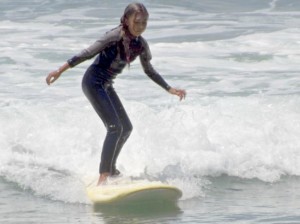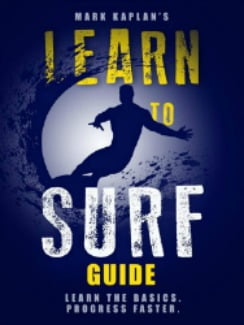Beginner Surfers Start with Foam Waves
Beginner surfers start with foam waves to learn the fundamentals. They also begin with soft top boards so that the surfboard is not an issue. The fundamentals for beginners barely change as surfers become advanced.
What changes are the techniques for real waves and the skill needed if surfers go to shorter boards. There is no reason the occasional surfer can’t keep the 8′ soft top for a life time as he progresses to real waves.

How to Catch Foam Waves
Foam waves occur after real wave break. Some beaches have much better foam waves for beginners, like Oceanside, CA. The foam waves rolls a long way before hitting the beach. The beginner positions himself far enough out so the foam wave has some push and is big enough to ride.
The surfer rolls onto his board when the foam wave is 20 feet away and starts paddling to get momentum. He looks back before it hits the board and when the wave is 5 feet from the board, he starts paddling hard.
It is important to keep paddling after the foam wave hits the board so that the board gets in front of the lip. If the surfer tries to stand while the tail is still in the foam, the board is more unstable. It requires about 3-5 paddles after the foam wave hits the tail of the board.
Advancing to Bigger Foam Waves
After riding the shore break, the surfer can paddle out through the foam waves to catch foam waves closer to where the real waves break. These waves will be bigger and moving faster. If the surfer does not have the fundamentals of catching and popping up mastered, the trouncings will be harsher.
As the surfer paddles through the first foam wave, he lets the nose of the board go under the lip and does a push up on the surf board so that the foam goes under his chest. If the wave is not too big, he can also put the surfboard on top of the foam wave. It is important to paddle hard through the wave so it doesn’t turn the board.
To turn the board, the surfer pushes water under the board on the side in which he wants to turn. If he wants to turn right, his right hand pushes water under the board as his left hand keeps stroking normally, one after the other.
It is important to be sure there is enough gap between the waves to easily make the turn. If the next wave is too close, the surfer turns back into the wave or can slide off the board to keep from getting hit sideways.
Most of the time, we learn the hard way by getting tumbled.
Learn More
My New Surfing Course in an E-Book plus Demo Video or Audio Version
Get the 18 Chapter, 7,500 word Course that can prepare you for a lesson or give you the fundamentals if you are going to try it on your own. 10 years of teaching 350 students a year has given me the insights on the most precise measures you must follow for success. This course is what I teach on the dry land and in water instruction. The Course includes a 15 minute video on my dry land and in water demonstration. Only $4.95
Buy the E-Book and start learning $2.99. Learn to Surf
Buy the Paperback on Amazon $7.95
Get Learn to Surf Course in 29 minute AUDIO. Great prep for a lesson, reviewing after a lesson, learning on your own, refreshing after not having surfed for a while. See Table of Contents. Only $7.95.

For Oceanside Surf Lessons, see the Home Page
See the Post Search Lessons Teach Fundamentals
See the Post Catching Real Surf Waves
See my Dry Land and in Water Demo video
See my other Surf site for more Posts
I have lowered the price of Courses and Books for the lock down price of $2.99
80 page Learn to Surf Book
![Surf Instructions Beginner to Advanced: Learn to Ride Waves by [Kaplan, Mark]](https://images-na.ssl-images-amazon.com/images/I/51HswFtoBQL.jpg)